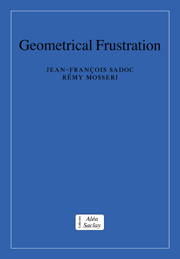
-
Select format
-
- Publisher:
- Cambridge University Press
- Publication date:
- 06 January 2010
- 12 August 1999
- ISBN:
- 9780511599934
- 9780521441988
- 9780521031875
- Dimensions:
- (247 x 174 mm)
- Weight & Pages:
- 0.71kg, 320 Pages
- Dimensions:
- (247 x 174 mm)
- Weight & Pages:
- 0.52kg, 320 Pages
You may already have access via personal or institutional login
Book description
This book shows how the concept of geometrical frustration can be used to elucidate the structure and properties of non-periodic materials such as metallic glasses, quasicrystals, amorphous semiconductors and complex liquid crystals. Geometric frustration is introduced through examples and idealized models, leading to a consideration of how the concept can be used to identify ordered and defective regions in real materials. Then it is shown how these principles can also be used to model physical properties of materials, in particular specific volume, melting, the structure factor and the glass transition. Final chapters consider geometric frustration in periodic structures with large cells and quasiperiodic order. Appendices give all necessary background on geometry, symmetry and tilings. The text considers geometrical frustration at different scales in many types of materials and structures, including metals, amorphous solids, liquid crystals, amphiphiles, cholisteric systems, polymers, phospholipid membranes, atomic clusters, and quasicrystals. Of interest to researchers in condensed matter physics, materials science and structural chemistry, as well as mathematics and structural biology.
Contents
Metrics
Altmetric attention score
Full text views
Full text views help Loading metrics...
Loading metrics...
* Views captured on Cambridge Core between #date#. This data will be updated every 24 hours.
Usage data cannot currently be displayed.
Accessibility standard: Unknown
Why this information is here
This section outlines the accessibility features of this content - including support for screen readers, full keyboard navigation and high-contrast display options. This may not be relevant for you.
Accessibility Information
Accessibility compliance for the PDF of this book is currently unknown and may be updated in the future.


